VIP editor talking to Ewa Olszewska-Borys, the world-famous medallic sculptor
VIP, Jacek Slubowski: A graduate of the Department of Sculpture at the Academy of Fine Arts in Warsaw with additional training at the École des Beaux-Arts in Paris, you have developed a fondness for medal making.
Ewa Olszewska-Borys: This is because a medal is a sculpture, a peculiar kind of small-size sculpture. At the Academy I was instructed in what is called sculpture in the round (my professor even thought I had the makings of a monumental sculptor), but I was a conscientious student of Zofia Demkowska's in her medallic studio. On entering -the world of the medal, I became immediately aware that no other kind of work could give me as much genuine satisfaction as this. Doesn't your question suggest, though, that sculpture and medal making are two distinct concepts? In some countries medallic art is indeed an offshoot of a craft, but the art I practise derives from sculpture and is sculpture.
VIP: So how are we to classify you as an artist?
E. O-B: To put it in a nutshell, I am a medallic sculptor.
VIP: What would you say a medal is?
E. O-B: A classical medal has two sides called the obverse and the reverse, and an edge. It can be viewed as two bass-reliefs with their backs to each other. Anxious to break away from tradition, contemporary medallic art tends towards greater spatiality of form. Central arrangement in a circle is no longer the binding principle. A flattened sculptural form with no division into the obverse and reverse may likewise function as a contemporary medal.
The medallic form is a paradox: on the one hand, it is obviously very small, on the other, there is often something monumental in its impact. Scale is not really important to the quality and experience of art. It's a matter of the viewer's imagination and sense of beauty. In its content and visual form, a medal may be just as monumental as a monument.

VIP: You have once compared a medal to a poem.
E. O-B: Poetry is a crisp, condensed form of literary expression. It has an enormous emotional weight and gives the reader much freedom of interpretation. There is something similar in the appeal of medallic art. The tiny form of a medal is a carrier of meaning and immense emotion. The pleasure of medal making is like that of writing poetry with sculptured forms.
VIP: How would you describe your own work, its characteristics traits?
E. O-B: The medal is a self-contained work of art in possession of its own allotment of space. In my medals, space is rendered through a tangible sculptured form which has replaced the traditional flat, symbolic background, as a result of which interpretation of reality has become possible. Matter and the space round it are indissolubly linked. My manner of sculpting brings out this peculiar link and may even create an impression of matter moving in space, in other words, an impression of movement, It is like going beyond the third dimension.
VIP: Have you got any pet subjects?
E. O-B: I adore portraiture. It offers a wealth of emotional and artistic experience. To find the right artistic expression for the very different personality traits reflected in the human face has always fascinated me. Abstract concepts are quite a challenge too. How can gratitude, for instance, or sanctities be conveyed in a medal? With tasks like these, I explore different emotional and perceptive domains. As it turns out, even abstract concepts can be contained within tangible sculptured forms. In this case, the hold over the viewer's imagination depends on the visual, not on the strictly objective, and this offer excellent potential for artistic fulfilment.
VIP: What about your favourite personages?
E. O-B: There are several. An artist's connection with a personage may be a bond for life. In my case, Copernicus is certainly a case in point. His likeness sculptured in a medal won me a competition long ago. Then came a series of commissions for Copernicus medals, all different from one another, naturally. I found it very inspiring and engaging.
Maria Sklodowska [Mme Curie] is a similar case. She was an extraordinary woman. I have always found her fascinating and liked sculpturing her portraits.
Chopin is another of my pet personages. I have made quite a few Chopin medals including that presented to the winners of the Grand Prix du Disque since 1985, a highly prestige award granted by the Frederic Chopin Society for the best Chopin record. The prize medals awarded to the winners of the 1995 and 2000 Chopin International Piano Competitions are likewise mine.
VIP: Your credits also include medals featuring Polish kings.
E. O-B: Yes, in the mid-1980s the Numismatic Society of the City
of Koszalin, Poland, addressed me with a commission for a series of medals
based on the Pageant of Polish Kings and Dukes by Jan Matejko [Polish
painter. 1838-1893]. I embarked on the task in 1985, making since two
to three medals yearly. I have got as far as Augustus III Wettin, so that
the series is coming to an end, with the only king left being Stanislaw
Augustus Poniatowski. I have made a point of interpreting Matejko rather
than reproducing his work. His portraits are full of depth and expression
and hence fantastically inspirational. After seventeen years with Matejko
I have developed a strong artistic bond with him, intensifying from one
medal to another, and I like him more and more. It's been going on for
a very long time, but I've managed to show quite a chunk of the history
of Poland.
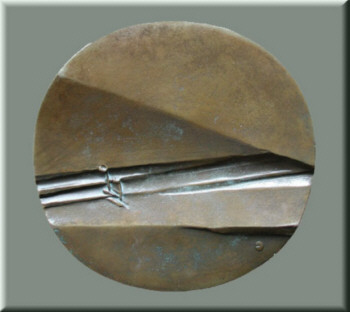
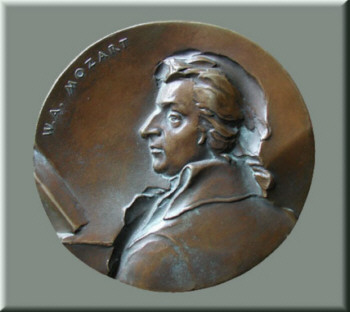
VIP: You are credited with a good many coins, aren't you?
E. O-B: Over thirty, to be precise, both collector's pieces and current coins. A series of coins featuring polish kings was issued in the 1970s and 1980s. My coins represent e.g. Boleslaw II the Bold, Casimir II the Restorer, Boleslaw III the Wrymouth and Wladyslaw I the Short. I resumed my collaboration with the national Bank of Poland after some interval, in the late 1990s. By this time my approach to coins had become somewhat different, shall I say artistically more mature? I am looking for new numismatic solutions. I designed a coin for the Bicentenary of the Dabrowski Mazurka [Polish national anthem], then several coins connected with Pope John Paul II and the Grand Jubilee of 2000. One of my latest is a coin celebrating the late Stefan Wyszyn'ski, Cardinal of Poland. The coin was struck as a collector's item in gold and silver, and as a current coin, two zlotys in value.
VIP: Let's go back to medals, though. How is a medal made?
E. O-B: I usually start by making a drawing. Then comes the stage of execution, i.e. sculpturing. I use plasticine. I like soft materials because of the freedom they offer. When the sculpture is finished, a plaster cast is made, and then a model. At the final stage, a medal is struck in mint or it is cast in metal. My medals are cast by my husband, likewise an art sculptor. When cast in bronze, a medal is cleaned, chased and patinated, after which it becomes a finished work.
VIP: You have won a number of prizes at home and abroad. Which do you consider the most important?
E. O-B: I attach no special importance to prizes awarded in competitions and very rarely take part in competitions. I quite often act as juror and I know to what extent chance decides to whom a prize goes. On the other hand, I highly appreciate individual appraisals of my works by people, aware of their quality who approach my oeuvre comprehensively. I know that in this case chance is ruled out. I have been fortunate enough to be awarded prizes for my lifetime achievement twice. In 1998 the Pax Institute awarded the W?odzimierz Pietrzak Prize to me. In 1993 the American Numismatic Society awarded me with the J. Sanford Saltus prize for signal achievement in the art of the medal, an important fact in my biography. I had a solo show in New York on that occasion.
VIP: A fairly prestige prize in the medallic world, isn't it?
E. O-B: It is. It has a long tradition, for it dates back to the
early 20th century. An annual prize, it has for a long time been awarded
to American artists on an exclusive basis. At some point, those in charge
decided that it should also be granted to acknowledged world medallists.
I was the first polish prize-winner, and I consider it a great honour.
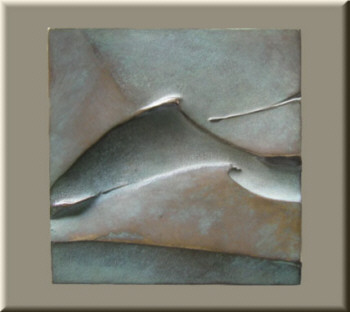
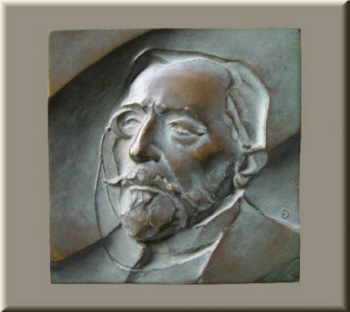
VIP: Isn’t it a bit like a Nobel prize or an Academy Award?
E. O-B.: A bit. It's indeed a prestige prize.
VIP: Could you tell us something about your meeting with the Queen of Belgians?
E. O-B: It was a unique adventure. In 1997, the secretary to Paola, the Queen of Belgians, addressed several artists with the request to submit medals to celebrate Her Majesty's sixtieth birthday. The Queen chose my medal and, pleased with my work, expressed the wish to see me. She suggested me spending a weekend at Saint-Tropez. Regrettably I was unable to go for family reasons. I was convinced the Queen would forget about me, but the invitation was resumed several months later. I went to Brussels and was received by the Queen at a long private audience, as long as an hour (apparently an unprecedented lengthy in the Royal palace. Amiably straightforward, the Queen spoke about the art of the medal with expertness and showed much interest in my work. In a letter received later on, Her Majesty thanked me for the medal made for her.
VIP: Isn't it a source of great satisfaction to have works in all major world museums?
E. O-B: It is. Could it be otherwise? What makes me especially happy, though, is that they are also in private collections because in this case I may be sure that my medals are alive; they are often handled and looked at.
VIP: What about your recent achievements?
E. O-B: Something's going on all the time. I have taken part in a huge important exhibition entitled ‘Treasures of the 20th Century’, organized by the famous Goldsmiths' Company in London. I was the only non-British artist invited, and I consider it another great honour. In 2001, the Society for the promotion of the Medal in Belgium mounted a solo show of my works, a sign of interest in what I do. I am always delighted when people are aware of the distinct traits of my work.One of my recent commissions is a medal sculpted for Princess Maxima of the Netherlands in commemoration of the title conferred on her.
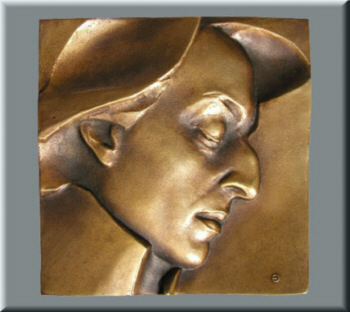
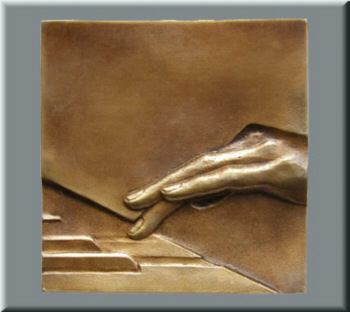
VIP: You are also active in FIDEM [Fédération Internationale
de la Médaille], aren't you?
E. O-B: I am. I joined the Federation in 1985 and have since acted as Polish delegate to Fidem, also sitting on the executive board and acting as vice-president between 1987 and 2000. At present, I am a member of the advisory board. I am anxious to promote Polish medallic art internationally. FIDEM organise congresses and international exhibitions once every two years. A limit is set on the number of medals entered by national delegations, but - having interesting achievements in medallic art - Poland is always allowed to present a good many pieces. I am in charge of the selection of Polish medals, and attend to their shipment and display. I take an active part in FIDEM congresses, giving talks and publishing papers. I believe that these endeavours may be of some help to Polish medallic art. Two important shows have been put on recently, one a joint American-Polish exhibition presented in the USA and in Poland, the other a show of contemporary Polish medals in Belgium.
VIP: Being as busy as you are, do you have any time left for ‘art for art’s sake’?
E. O-B: The point of what I do is always art, not craftwork or anything else. The specific purpose for which a medal is made is not important, what matters is the impression it makes, its appeal. I work on the assumption that creative work should be a source of satisfaction to the artist, never embarrassment. Whether I work on commission or on my own initiative, it's always a case of art for art's sake.
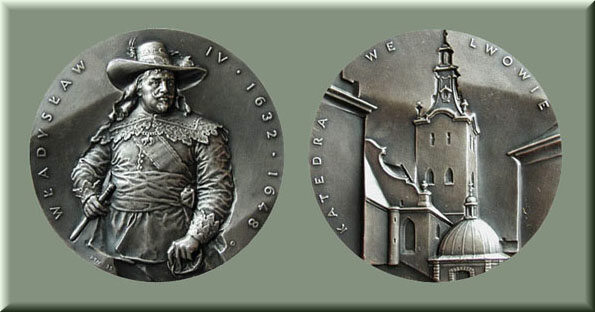
VIP: What about your plans for the near future?
E. O-B: A solo show of my works in Cracow is due in the spring of 2003, my first in the city and therefore important. I am plucking up courage to write on the art of the medal, on my theory of sculpturing space, to be precise, an absorbing and challenging task. I don't neglect my current work and I certainly can't complain about not having enough to do or not enough chance of self-fulfilment.
VIP: Many thanks for the interview, for introducing us to the fascinating
world of the medal.
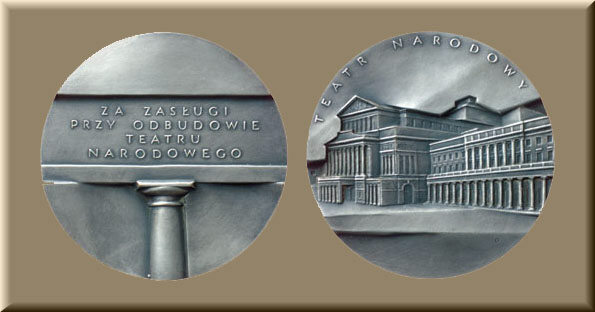
Photographs:
Fig. 1. Ewa Olszewska-Borys with her dog
Fig. 2a. Medal Mozart, reverse, cast bronze.
Fig. 2b. Medal Mozart, obverse, cast bronze.
Fig. 3a. Medal Conrad, reverse, cast bronze.
Fig. 3b. Medal Conrad, obverse, cast bronze.
Fig. 4a. Medal Touch, obverse, cast bronze.
Fig. 4b. Medal Touch, obverse, cast bronze.
Fig. 5ab. Medal Wladyslaw IV from the series of Polish Kings and Princes, obverse and reverse, struck bronze, silvered.
Fig. 6ab. Medal National Theatre, obverse and reverse, struck bronze, silvered.
Interview and photographs: Jacek Slubowski
VIP, no. 10, 2002, Warsaw